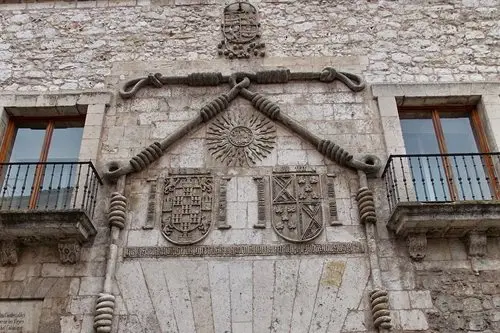
Cookie settings
We use our own and third-party cookies in order to offer our services, display videos, obtain statistics and offer personalized advertising.
For more information, please read our cookies policy.

Its construction started in 1221, and it was finished in 1765. It has a Latin cross plan, with three naves, transept and 19 chapels that are irregularly distributed. The dome of the transept is octagonal, flanked by eight big pinnacles. The central nave is closed by great railings, and it is divided into three parts: the Major Altar, the Choir and the Transept.
It is illuminated by ogive windows and it is surrounded at half way up by a gallery. In the centre, a beautiful 50 m high dome has been built. The 84m high octagonal arrows of the bell towers were carried out by Juan de Colonia.
The main access is located in the Puerta del Perdón (Door of Forgiveness), in whose centre we should highlight a great star- shaped rose window and a gallery with statues of the Castilian Kings and Saints, and all this complex is dominated by a statue of St Mary, with a Latin inscription that says “Pulcra es et decora”. Two 84 m towers, crowned by spectacular step spires from the XV, are built on both sides.
Another important door is the Portada del Sarmental (Door of El Sarmental) that was built in 1230. The figure of Jesus Christ surrounded by the four evangelists and with the twelve apostles below appears represented in the tympanum that is surrounded by three archivolts in which the old men of the Apocalypse are represented and which is crowned by a marvellous rose window. Over the door, divided by a mullion, appears the statue of the bishop Don Mauricio.
Inside the temple, we should highlight the Major Chapel, created by Rodrigo and Martín de la Haya in collaboration with other artists. It has a Renaissance altarpiece of St María the Great, with three bodies and five bays with themes such as Eucharist, the Virgin, the Apostles or the Saints´ Adoration. It occupies the apse of the central nave.
The Chapel of the Condestable, from the XV Century, was created by Simón de Colonia and it was ordered by the Condestables: D Pedro Fernández de Velasco and Dª Mencía de Mendoza. It has an octagonal floor. We should highlight a huge fan vault opened to the zenith light. The sepulchres are sculpted into beautiful marble, and were carried out by Felipe Vigarny in 1534 and the altarpiece is a Felipe Vigarny and Diego de Siloe´ s work.
Another important chapel is the Chapel of St Tecla, from the XVIII Century, with a beautiful semi-spherical dome and with Baroque ornamentation. The image of St Tecla in the bonfire is attributed to Alejandro Carnicero.
The Golden Staircase, situated on the left side of the transept and from the XVI Century, is a Diego de Siloe´ s work that was finished in 1523. The silver banister with the golden ornaments was carried out by the French artist Maestre Hilario. It has nineteen steps that fork in diverging arms that converge in front the door. It is inspired in models of the Italian Renaissance.
The primitive dome was carried out by Juan de Colonia, but it was collapsed and Juan de Vallejo was who built the current one in the XVI Century. It rises over the transept, and it is supported by four huge columns where a system of scallops gives rise to the great octagon that culminates in the amazing star.
The Cloister, decorated with monumental sculptures such as the Adoration of the Magi and the Annunciation with two Prophets, constitutes a real museum of sacred art. A unique collection that includes: objects, altarpieces, choir´ s set of chairs, tombs, paintings and sculptures.
Address and telephone
Opening times
Prices
If you see any mistakes or want to add anything to this information, please contact us.


